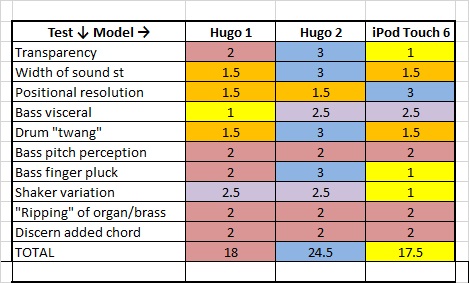I'm lucky in the that I cannot hear most of the fine detail others seem to be able to hear, so for me a piece of gear has to really add significant value to be in my chain. Also, I will disclaim that I received the Hugo 2 on a free tour.
The unit feels a bit heavy in the hand, which is to be expected for such an expensive piece of gear. I wouldn't want to use it while walking around or anything, but if you needed to take it home after work in a backpack, or take it with you on travel to set up a rig at your destination, that would work.
The LEDs are bright, but there is a dim option. There's a bare LED inside the device that changes color based on the input kind, and that LED can shine right in the eye at certain angles. This is quite bothersome.
The whole colored interface is silly IMHO. I suppose if I had the devices all the time I might get used to it, but there are 34 different ball/color combinations, not including the volume colors. While the colored balls is innovative, it's not good innovation.
There's a remote. I didn't use it. I suppose if you used the Hugo 2 as DAC with amplified speakers, the remote might be useful.
Bluetooth is only for streaming to the DAC. Again, not sure when this would used for people with a $2100 DAC, but maybe with power speakers on travel? But who brings nice powered speakers when traveling.
As for the filters, they do nothing for me. I had a friend with much better ears (he's a musician and sound mixer) and he also could not hear any difference with the filters.
The crossfeed is well implemented, but all the "on" settings for the crossfeed sound the same to me. It should have been an on/off switch.
I suppose the battery is there more for control over power rather than for portability. That's cool as charging it is easy, and it has all sorts of tech to allow it be charged while playing with no ill effects. I understand it can be plugged in all the time, also with no ill effects.
Sound wise, let's start with the Sennheiser IE80 IEMs. I compared the same music, in ALAC format between the Hugo 2 and my iPad, and I could not hear a difference. I played all my audition songs that I know very well. Maybe the IE80s aren't resolving enough. Maybe I am not sensitive enough. Maybe my ears aren't trained well enough. Meh.
My main solid state audio chain is a Mac, USB to a Bimby, RCA to Auralic Taurus Mk II. This is what I compared the Hugo 2 to. I used a Utopia for most of the listening. Some was with the TH900.
Both headphones sounded wonderful out of the Hugo 2, but I felt I squeezed a tad more detail from the Bimby/Taurus, while the Hugo may have a slightly larger sound stage and was a little less punchy or fatiguing. Differences were small--tiny, which is a testament to the Hugo 2 as the other two "full sized" items retail for about the same price.
Just as a DAC, with the Hugo 2 feeding the Auralic Taurus II, comparing to the Bimby; very hard to tell for me, but the Bimby seems a tad smoother than the Hugo 2. The reverse might be that the Hugo 2 has a bit more extension into the upper range. Not harsh at all, and possibly a bit more detailed, but hard for me to tell. The difference becomes more apparent with a piano solo. Since the Taurus is considered a very neutral amp, the shift is perception between the DACs was interesting.
Finally, I compared the Hugo to the Bimby & Mjolnir 2 with some great WE396a tubes. I definitely preferred the Schiit stack, as did my buddy. Obviously, YMMV.
I enjoyed my time with the Hugo 2, but it's not for me. I'm not sure what the market for it is. It's too big to compete with the Mojo as a portable, and priced too high to compete with a desktop stack that can drive harder to drive headphones better. It drove the Utopia very nicely, but I prefer a tube amp. As a DAC, the much less costly Bibmy was just as good, to me, and there are many fantastic DACs available for way less than the Hugo 2. I suppose the market would be people that want a great set up at home and at work (or on travel), and are willing to carry between. Also, anyone with easy to drive headphones that need a very very small rig would benefit.
I also suppose you could have active speakers, or a speakers and an amp, and the Hugo 2 and a source, and you would have a nice system. The remove might be useful there.
I think if you look at the Hugo 2 as a $2100 DAC with some extra features, it makes more sense. It's a $2100 DAC that can drive IEMs and some headphones when needed, is portable, has a remote, and has the ability to switch between four inputs. It's a pre-amp/DAC plus.
The unit feels a bit heavy in the hand, which is to be expected for such an expensive piece of gear. I wouldn't want to use it while walking around or anything, but if you needed to take it home after work in a backpack, or take it with you on travel to set up a rig at your destination, that would work.
The LEDs are bright, but there is a dim option. There's a bare LED inside the device that changes color based on the input kind, and that LED can shine right in the eye at certain angles. This is quite bothersome.
The whole colored interface is silly IMHO. I suppose if I had the devices all the time I might get used to it, but there are 34 different ball/color combinations, not including the volume colors. While the colored balls is innovative, it's not good innovation.
There's a remote. I didn't use it. I suppose if you used the Hugo 2 as DAC with amplified speakers, the remote might be useful.
Bluetooth is only for streaming to the DAC. Again, not sure when this would used for people with a $2100 DAC, but maybe with power speakers on travel? But who brings nice powered speakers when traveling.
As for the filters, they do nothing for me. I had a friend with much better ears (he's a musician and sound mixer) and he also could not hear any difference with the filters.
The crossfeed is well implemented, but all the "on" settings for the crossfeed sound the same to me. It should have been an on/off switch.
I suppose the battery is there more for control over power rather than for portability. That's cool as charging it is easy, and it has all sorts of tech to allow it be charged while playing with no ill effects. I understand it can be plugged in all the time, also with no ill effects.
Sound wise, let's start with the Sennheiser IE80 IEMs. I compared the same music, in ALAC format between the Hugo 2 and my iPad, and I could not hear a difference. I played all my audition songs that I know very well. Maybe the IE80s aren't resolving enough. Maybe I am not sensitive enough. Maybe my ears aren't trained well enough. Meh.
My main solid state audio chain is a Mac, USB to a Bimby, RCA to Auralic Taurus Mk II. This is what I compared the Hugo 2 to. I used a Utopia for most of the listening. Some was with the TH900.
Both headphones sounded wonderful out of the Hugo 2, but I felt I squeezed a tad more detail from the Bimby/Taurus, while the Hugo may have a slightly larger sound stage and was a little less punchy or fatiguing. Differences were small--tiny, which is a testament to the Hugo 2 as the other two "full sized" items retail for about the same price.
Just as a DAC, with the Hugo 2 feeding the Auralic Taurus II, comparing to the Bimby; very hard to tell for me, but the Bimby seems a tad smoother than the Hugo 2. The reverse might be that the Hugo 2 has a bit more extension into the upper range. Not harsh at all, and possibly a bit more detailed, but hard for me to tell. The difference becomes more apparent with a piano solo. Since the Taurus is considered a very neutral amp, the shift is perception between the DACs was interesting.
Finally, I compared the Hugo to the Bimby & Mjolnir 2 with some great WE396a tubes. I definitely preferred the Schiit stack, as did my buddy. Obviously, YMMV.
I enjoyed my time with the Hugo 2, but it's not for me. I'm not sure what the market for it is. It's too big to compete with the Mojo as a portable, and priced too high to compete with a desktop stack that can drive harder to drive headphones better. It drove the Utopia very nicely, but I prefer a tube amp. As a DAC, the much less costly Bibmy was just as good, to me, and there are many fantastic DACs available for way less than the Hugo 2. I suppose the market would be people that want a great set up at home and at work (or on travel), and are willing to carry between. Also, anyone with easy to drive headphones that need a very very small rig would benefit.
I also suppose you could have active speakers, or a speakers and an amp, and the Hugo 2 and a source, and you would have a nice system. The remove might be useful there.
I think if you look at the Hugo 2 as a $2100 DAC with some extra features, it makes more sense. It's a $2100 DAC that can drive IEMs and some headphones when needed, is portable, has a remote, and has the ability to switch between four inputs. It's a pre-amp/DAC plus.


























